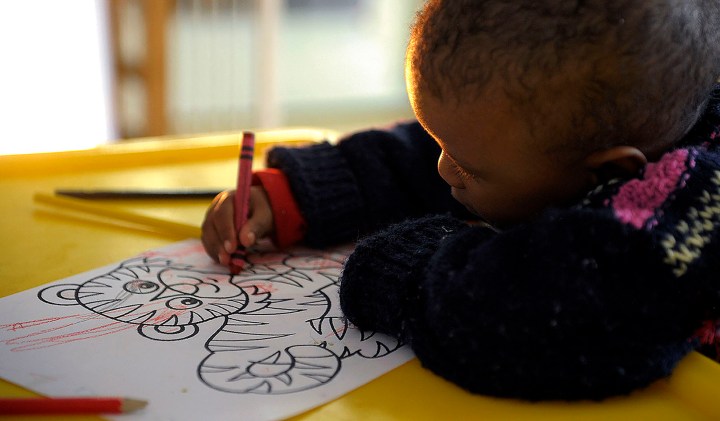CHILD AND FAMILY SERVICES OP-ED
Women-led ECD sector still receives a tiny slice of the budget pie

Investment in Early Childhood Development ensures a solid foundation for our young children and harnesses the potential of a women-led care economy.
Despite the increasing recognition of the importance of Early Childhood Development (ECD), financing for the sector continues to be a drop in the ocean of what we need to reap the rewards of a women-led, adequately funded and high quality ECD sector.
The 2022/23 Budget and Division of Revenue Bill (the Bill) — which determines how the government’s revenue will be allocated to the national, provincial and local spheres of government — shows that the national budget for ECD has not increased and, in real terms, decreases due to inflation.
It is a well-known fact that investment in high quality ECD has the potential to unleash the wellbeing and future prosperity of families across the country.
By the age of five, almost 90% of a child’s brain will be developed. These are the formative years where adequate healthcare, nutrition, good quality childcare and nurturing, a clean and safe environment and early learning and stimulation will, to a large extent, influence their adult lives.
Investment in ECD not only lays essential developmental foundations for children; it also harnesses the potential of a women-led care economy, which has been historically underpaid and overlooked, despite being the backbone of our health, education, household and economic systems.
Our government has publicly recognised these societal benefits on numerous occasions.
More recently, President Cyril Ramaphosa noted in his 2022 State of the Nation Address that “the social economy, including ECD… has significant potential not only to create jobs, but to provide vital services that communities need”. The National Development Plan (NDP) also places ECD as “a top priority among the measures to improve the quality of education and long-term prospects of future generations.”
More dated is a 2015 report on the status of women in the South African economy done by the Department of Women which recommended that “… accessible and affordable child care facilities such as crèches and nursery schools and ECD centres are made available in order to promote women’s increased participation rates within the economy, and in self-employed and entrepreneurial activities of women.”
Yet the budget allocation for ECD still does not reflect these sentiments. As it stands, only roughly 0.03% of South Africa’s national expenditure is spent on early learning, nutrition support and responsive parenting interventions for children aged 0-5.
ECD as a women-led sector
Globally, the child care and education sector is female dominated and commonly associated with low status and low pay and, in South Africa, it relies heavily on the labour of black women. This under-valuing of social and domestic labour reflects a persistent bias in under-valuing women’s labour.
According to the Women’s Report published in 2021, ECD services are provided by predominantly non-profit organisations, subsistence entrepreneurs, or social micro-enterprises (particularly in poor communities). A Department of Social Development (DSD) survey found that over 95% of key staff at these early learning programmes (ELPs) are women.
Visit Daily Maverick’s home page for more news, analysis and investigations
A recent ILO and Wiego study identified that “the vulnerability of childcare workers — assessed by their status of employment and their place of work — is directly related to the level of public financing for childcare services.”
Currently, the main public financing for ECD is through a per child per day subsidy. The subsidy is distributed to registered early learning programmes (ELPs) to support the quality, and reduce the cost of the programme for primary caregivers. The value of the subsidy is R17 per child per day, for 264 days a year, amounting to a maximum of R4,488 per child per year and only 40% of this may be used for salaries.
This is wholly inadequate to ensure high-quality early learning which is imperative to reap the rewards of investment in ECD. In order to fund a basic level of quality within ELPs, it is estimated that the subsidy should be approximately R30 per child per day — almost double the current subsidy.
To make matters worse, only a small proportion of young children actually attend subsidised ELPs. We estimate that the current number of children benefiting from a state subsidy is around 20% of the number that should be subsidised at universal access (based on a calculation done by Ilifa Labantwana using the general household survey).
The chronic under-resourcing of ELPs has significant consequences for children in South Africa. The 2021 ECD Census highlights that ELPs are critically under-resourced with only 56% of ELPs having age-appropriate books, and only 34% having access to an outdoor playground with suitable equipment. The recent Thrive by Five Index suggests that only 31.5% of children aged 4-5 are on track in terms of learning and physical development, and are ready to start school, while 19.7% face significant barriers to thriving.
Restricted access to state subsidies, and the low value of the subsidies which do not meet the full cost of provision, mean that parent fees remain the primary source of funding for most ELPs. This is despite 30.3 million (55.5%) South Africans living below the poverty line.
Way forward
As ECD civil society organisations, parents, practitioners and other stakeholders, we need transparent budgets, especially pertaining to subsidies. A concrete start for the Department of Basic Education (DBE) is to set transparent targets for the ECD subsidy over the three-year Medium Term Expenditure Framework period.
Although a subsidy for high quality ECD should be about R30 per child per day, the government fiscus is shrinking and inflation is increasing. At the very least, the ECD subsidy should be increased to R17.50 in 2023/24, and reach at least 717,767 children, as stipulated in the Department of Social Development’s Vote 19 2021. The prescription that only 40% of the ECD subsidy can be used for salaries should be removed, allowing ELPs to determine the best use of funds in line with their needs.
To ensure that the above is possible, the combined ECD Conditional Grant and Provincial Education Department budgets should be at least R3.37-billion.

Basic Education Minister Angie Motshekga said: “We do believe that early childhood education is the foundation for development and for growth.” (Photo: GCIS)
At the handover of the ECD function from the DSD to DBE in April 2022, Basic Education Minister Angie Motshekga said: “There is no way of building a better future than focusing on and reinforcing the early foundation. We do believe that early childhood education is the foundation for development and for growth.”
We whole-heartedly agree and now is the time for the government to put its money where its mouth is. DM/MC
Laura Brooks is an economist at Ilifa Labantwana, Kayin Scholtz is the ECD Resource Hub Manager at the DG Murray Trust and Zoe Postman is the Head of Communications at the Equality Collective. These organisations form part of the Steering Committee of the Real Reform for ECD Campaign under which this article is published.




















 Become an Insider
Become an Insider
Comments - Please login in order to comment.